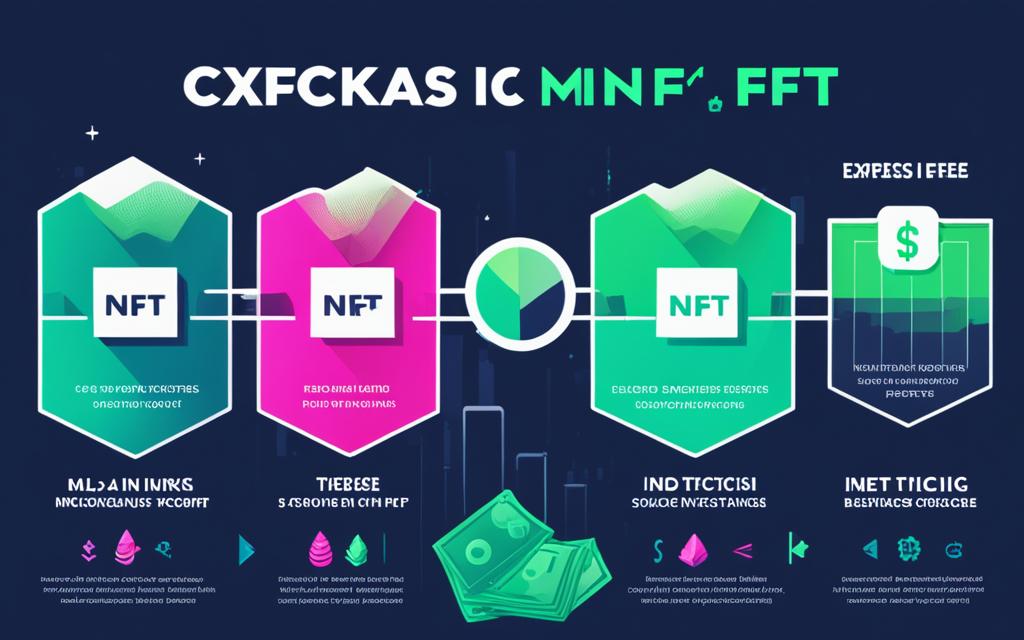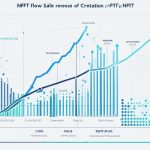Minting an NFT has various costs to think about. Gas fees are a big part of these costs. These fees change based on the blockchain you use. Ethereum is the most used blockchain for NFTs, but it also has the highest gas fees. This makes minting NFTs on Ethereum more costly, with prices ranging from $50 to $200. This depends on network traffic.
For cheaper options, Binance Smart Chain is a good choice. Its minting costs are between $1 and $10. These lower fees are great for creators with tight budgets.
Different NFT marketplaces also have their own fees. OpenSea takes a 2.5% cut of the sale price for minting. Rarible does the same. SuperRare charges a 3% fee based on the buyer’s price.
Network gas fees are a big factor in overall minting costs. These fees go up and down with network use. When the network is not busy, gas fees on Ethereum could be $50 to $150. But in busy times, costs can jump a lot, sometimes to hundreds of dollars per transaction.
Smart contract fees can also increase minting costs. This is true especially for NFTs that use complex smart contracts. It’s important to think about these extra costs.
Knowing all the costs for minting an NFT helps with budgeting. Choosing a blockchain, understanding marketplace fees, and considering smart contract costs matter. All these things add to the total cost.
You can lower gas costs on Ethereum with some tricks. Minting many NFTs at once can save money. Doing transactions when the network is less busy also helps. So does paying more for gas, or using solutions like ImmutableX or Polygon for cheaper fees.
Other blockchains like Solana also offer low-cost minting. Solana’s fees are almost zero, making it great for creators. Minting 50 NFTs on Solana costs less than a dollar. Tezos and Flow are also budget-friendly with their low gas fees.
Minting costs are not the only expense for creators. They also need to think about design and development, marketing, and trading fees. Trading fees in secondary markets can be 8% to 15% per trade. This is important for planning an NFT project.
Understanding all costs and finding ways to save helps in making good minting decisions. Considering different blockchains, saving on gas, and planning for extra costs are key. Knowing the full cost breakdown is essential for success.
For more details on minting costs, check out these resources:
1. TokenMinds: Offers insights on minting costs and compares blockchains.
2. Vega Vid: Talks about mining costs and cost-saving blockchains.
3. Wagmi Tips: Provides guides on minting costs and important factors.
Factors Affecting NFT Minting Costs
Minting NFTs involves some costs that creators need to understand. By knowing these factors, they can pick the best options to save money on their NFT projects.
The blockchain you choose affects how much you pay to mint NFTs. Each blockchain has its own fees. For instance, Ethereum is pricier because of high gas fees. On Ethereum, minting an NFT could cost between 16 to 20 gwei, which is about $0.38 to $0.46 USD. Sometimes, the fees on Ethereum have even hit $500.
But, cheaper alternatives exist. Networks like Binance Smart Chain, Solana, Algorand, Cardano, Tezos, Flow, and Polygon are less costly. For example, Binance Smart Chain asks for 0.005 BNB ($1.24), and Solana only 0.00045 SOL ($0.0081). Prices vary across these networks, offering budget-friendly options for creators.
Network traffic also affects minting costs. High congestion on a network means higher fees. So, it’s wise to mint NFTs when the network isn’t too busy to avoid extra costs.
Moreover, NFT marketplaces add their own fees, like listing and transaction charges. Each marketplace has a different fee structure. Creators must research these fees to manage their minting budget effectively.
The Benefits of Understanding NFT Minting Costs
Understanding minting costs helps creators budget smarter and increase their profits. Knowing about different blockchains and their costs lets creators choose the most affordable option.
Being aware of network congestion and marketplace fees helps in planning. Creators can avoid high costs by choosing the right time and platform to mint their NFTs.
Using strategies like lazy minting can also cut down on expenses. This method delays fees until an NFT sells. Choosing an affordable blockchain like Flow, which has over $1 billion in NFT sales as of June 2022, makes minting cost-effective.
Getting a grip on minting costs is crucial in the evolving NFT market. By assessing costs and considering savings strategies, creators can successfully sell their digital creations without overspending.
Benefits of Understanding NFT Minting Costs
Knowing NFT minting costs helps creators and businesses in many ways. They can efficiently plan their budgets. This allows them to choose the best blockchain and marketplace for their NFTs.
Creators can save money with strategies like lazy minting. This method lets them pay fees only after their NFT sells. They can also pick the most popular and competitive platforms by understanding minting costs.
Getting familiar with these costs means creators can mint more successfully. They’re better equipped to explore the NFT world, find new chances, and reach more people.
FAQ
What are the costs associated with minting an NFT?
When you mint an NFT, you’ll have a few costs. These include gas fees and fees charged by marketplaces. Gas fees change based on the blockchain you use. For instance, Ethereum has the highest fees around.
However, some blockchains like Solana and Cardano offer lower fees. Also, platforms like OpenSea and Rarible let you list an NFT for sale before actually minting it. This way, you won’t have to pay gas fees right away.
Does Ethereum’s transition to proof-of-stake result in lower gas fees for minting NFTs?
The short answer is no. Switching Ethereum to proof-of-stake hasn’t cut gas fees. You still need to think about these costs when you mint NFTs on Ethereum.
How can creators save on minting costs?
Creators have a few ways to save money. They can use networks like Polygon, which can be cheaper. Some marketplaces also offer ways to mint NFTs without paying gas fees upfront, called gasless or lazy minting. These options let you mint NFTs for free or wait to pay fees until the NFT sells.



















